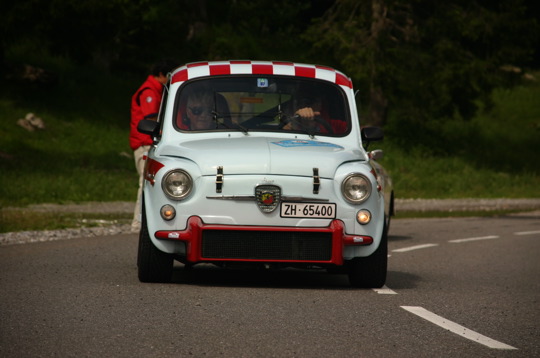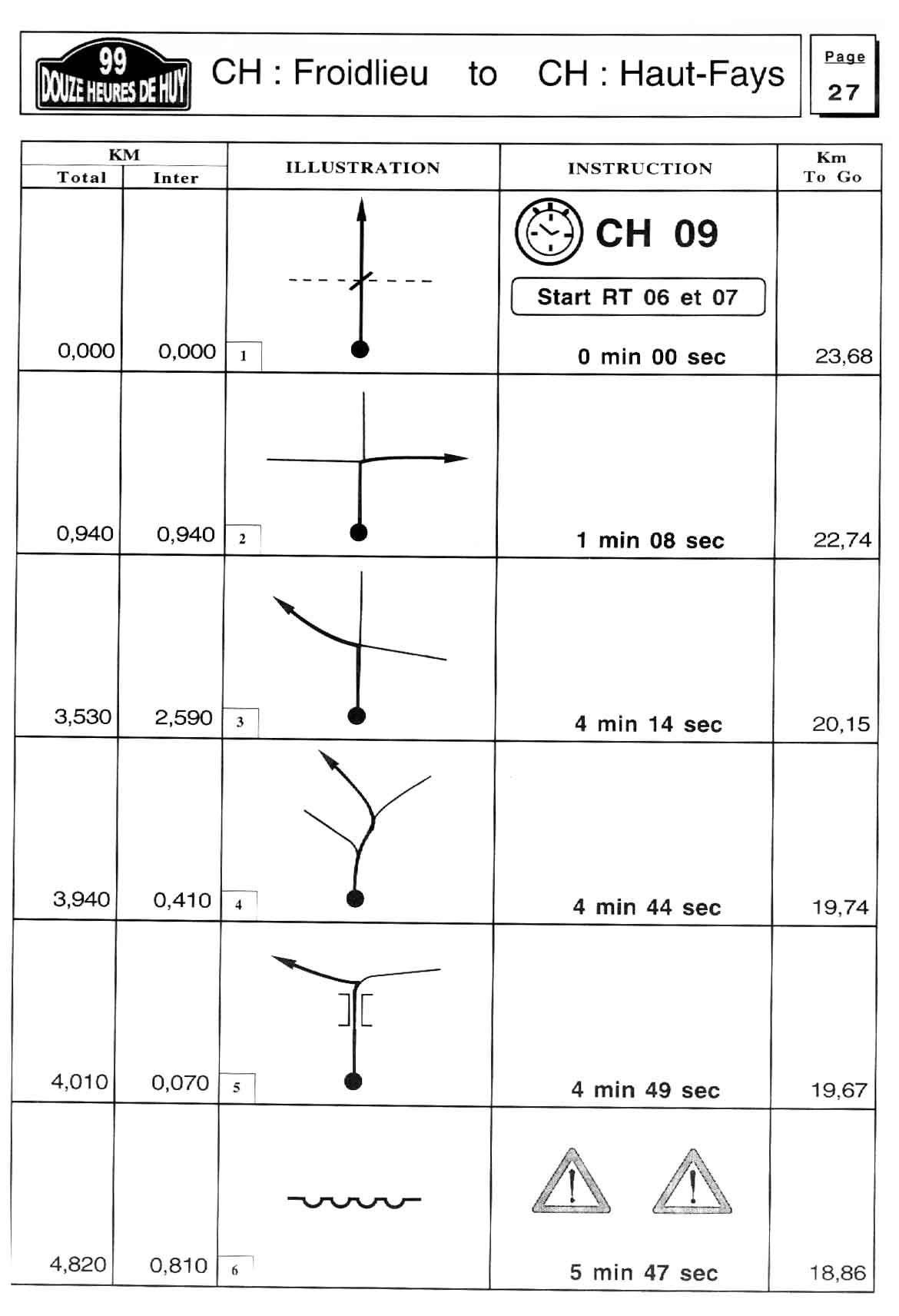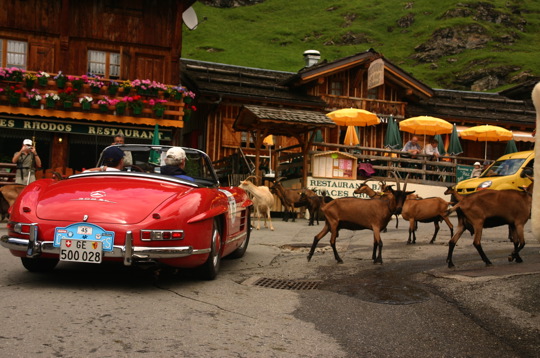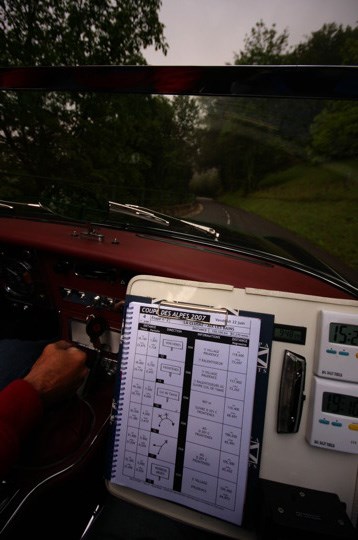
In the road book, any regularity section will be mentioned as "RT" (Regularity Test), and the organizer will have specified the average speed either in the road book, on the road map, or during the briefing.
So, to sum up, a regularity sector can use any note system, but here it is no longer enough to arrive on time at the final sector CH, but you also have to keep a constant speed throughout the sector.
Well, obviously, in absolute terms, a constant speed is impossible since it will be necessary from time to time to brake for a turn or a crossroads.
Indeed, and what you need to know is that the organizer will hide commissaires who will check the flight time of the competitors' passage at a given location. Knowing the distance which separates this place from the starting line, the commissary knows what is the ideal time of passage considering the constant speed, and any difference compared to this time will be penalized.
Let's take an example. A 10 km section is to be completed while keeping an average of 30 km / h, which corresponds to 2 minutes per kilometer. If the commissioner is hiding 6 kilometers from the start, only cars passing 12 minutes after their departure will not take penalties. The marshal therefore has no radar to measure the speed of the competitor, who could very well do instant 70 km / h here to make up for the time lost during an error at kilometer 4.
Most often, an RT is combined with a normal section ending in a CH, but the RT ends a little earlier. In the previous example, the organizer will therefore indicate that the RT ends between kilometer 7 and 8 for example. The average of the CH may even slightly differ from that of the RT, provided that this does not oblige the participant to exceed the speed limits at the end of the section.
In the same vein, the organizer never controls a RT in the first meters of the sector, to give the participant time to start. The road-book will therefore often mention: "Time taken by RT after 2 kilometers minimum". Participants will therefore take a step ahead at the start, and once they arrive at km 2, will align themselves on the ideal weather.
In practice, since nobody knows or hides the marshals during a regularity sector, the crew proceeds as follows:
We place in plain view an average table, indicating the ideal passage time from kilometer to kilometer, for each average speed between 30 and 50 km / h.
Every 500 m, or every kilometer, the navigator (or the pilot) looks at the ideal time for the mileage carried out, and accelerates or slows down (Or stops if he is really too early). Once re-aligned, the pilot uses his speedometer to maintain an ideal speed, until the next kilometer where he restores the point.
Well, in view of the difficulty, it is good to put things in focus: a minute late is usually penalized as much as a minute late in a CH. The only real difference is that the organizer counts RT penalties by the second and not by the minute, but a second only "costs" a 60th minute, so in fact, a RT is more selective; but not more risky. Yep, that's not entirely true when you realize that you can be penalized several times in a row in the same RT sector, which never happens at a hospital since there, we always leave without penalty . We can never say it enough, the main thing is to keep the itinerary. A little early, or a little late, it's all for super-pros. All beginners would do better to read the notes in the road-book than to burn their eyes on the clock, because if they go the wrong way, everything is ruined anyway, not to mention the CPs that we could miss .. A word to the wise ...
In the following example, the organizer has pre-calculated the ideal times for each note, which greatly facilitates the task of the navigator. The average is here at 49.9 km / h

Average tables
All the crews use averages tables, to quickly know if we are ahead or behind.
Download my tables here.
In practice, I print a small notebook, with two pages per medium speed. The spiral bound notebook is placed on a tablet in plain view of the pilot and navigator. To create a complete notebook, it is necessary to modify the basic speed in the table, then to print the page, and then to cut out the whole.
Average changes under RT
As this was not enough, the organos have other ways to drive you crazy: they ask you to change the average right in a regularity sector.
Example:
Between CH 4 and CH 5, sector 10 km long, to be completed in 15 minutes (40 km / h = 90s / km)
Departure from CH4 under RT1 at 50km / h (72s / km)
After 4 km, end of RT1, departure RT2 at 30km / h (120s / km)
End of RT2 between km 8 and 9
This example shows that the 10 km section is in fact divided into three portions: 50 - 30 -?. The speed to follow during the third section is unknown because we do not know exactly where the RT2 section ends.
Suppose the end of RT2 is 8 kilometers away:
the first 4 km section is to be completed in 288 seconds (4 * 72), i.e. 4 minutes and 48 seconds.
the second section of 4 km is to be completed in 480 seconds also (4 * 120) or 8 minutes
132 seconds remain to complete the last 2 kilometers, an average of 54 km / h
But in fact, there is no point in knowing exactly how fast the last section should be, since it is no longer in RT, but you just have to be a little early in CH5, and wait for the ideal time. On the other hand, the real difficulty is to understand what to do at kilometer 4.
We have three possibilities:
We are perfectly on time, in which case we reset the time and the trip to zero at kilometer 4 precisely (The time indicating 4'48 ")
We're early. You just have to stop at kilometer 4 and reset the trip to zero. Once the time indicating 4'48 ", we start again and reset the time to zero.
We're late. It is not dramatic, but it takes a little discipline, that the delay will complicate because it is stress on board! Well, all you have to do is reset the clock once it displays 4'48 ", even if you haven't reached kilometer 4 yet. Then, you reset the trip to zero once you've crossed km 4 .
If by bad luck we forget to reset the trip to zero (or the stopwatch), it is always possible to do it the next kilometer, and then mentally add 1 kilometer to each reading of the trip. Ditto for the stopwatch, we will then reset it to zero when it indicates 5'58 "but we will have to mentally add 1 minute to the value read. I use" Post-It "which I stick on the windshield to remember the reports to be made on the readings.
Changes in average without reference distance
Well, all of this is still possible when the change in average is indicated with a mention of distance.
If on the other hand, it's something like "At the level of the church in the village of Rochefort, start RT2", we will have to think again. The best as always is to be there on time, so we reset the time and the trip to zero, and we leave for the RT2. But, in doubt, note the mileage achieved to arrive at the church, and then read the ideal time for this distance on the table. Calculate the deviation from the ideal time (ex: 15 seconds delay) and quickly start again after resetting the trip and the stopwatch. All subsequent readings from the clock must mentally be corrected by the calculated difference (In our example, add 15 seconds).
Another possibility, exploited during the 6 hours of Seraing 2002, is to mention that in all RT, the sections in the agglomerations are done at 38 km / h, and 48km / h outside. This therefore means a multitude of changes in averages in the same RT. The first solution is that described above, it is very precise, but quite tedious. The second more empirical can be summarized as follows:
we only look at the 48 km / h table
at the agglomeration entrance panel, we take stock of the advance or possible delay, and note this value on a post-it. The total mileage is also noted. If we are ahead, we wait at the sign. If we are late, we go straight back to the city.
In the conurbation, the pilot tries to do 38 km / h at random if he is on time, and 50 km / h if he is late.
At the end of the agglomeration, note the total mileage, then calculate the length of the agglomeration, since you have the start mileage. then calculate the additional time to be counted by speed difference (Between 38 and 48km / h, there are 20 seconds per kilometer).
For the rest, we always follow the table of 48, but adding the supplement calculated in the previous point. For example, if the agglo was 1.5 km, we must add 30 seconds to the values read on the 48 km / h table.
This second method only works well if the agglomeration is not too long, because inside it, we do not follow the prescribed speed very precisely.
Next Section: Vehicle Equipment









